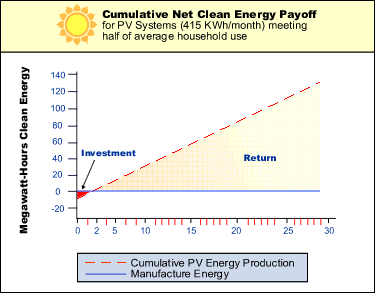kaptiankrush
Member
- Dec 20, 2016
- 190
- 9
- 16
- Banned
- #1
Though I am still in favor of photovoltaic solar cells, does anybody know if they produce more energy over their lifetimes than the energy needed to create them?
Follow along with the video below to see how to install our site as a web app on your home screen.

Note: This feature currently requires accessing the site using the built-in Safari browser.
 A study by the National Renewable Energy Laboratory conclusively demonstrates that energy payback for photovoltaics (PV) is generally less than 4 years. You may download a free copy of the study here. It states:
A study by the National Renewable Energy Laboratory conclusively demonstrates that energy payback for photovoltaics (PV) is generally less than 4 years. You may download a free copy of the study here. It states:FACT: A study by the National Renewable Energy Laboratory conclusively demonstrates that the manufacturing energy cost versus the energy production payback for solar modules is generally less than 4 years.
A study by the National Renewable Energy Laboratory conclusively demonstrates that energy payback for photovoltaics (PV) is generally less than 4 years. You may download a free copy of the study here. It states:
“Reaping the environmental benefits of solar energy requires spending energy to make the PV system. But as this graphic shows, the investment is small. Assuming 30-year system life, PV-systems will provide a net gain of 26 to 29 years of pollution-free and greenhouse-gas-free electrical generation … So, for an investment of from 1 to 4 years worth of their energy output, PV systems can provide as much as 30 years or more of clean energy.”
Solar Energy Facts California | Solar Power Myths | Solar Energy Myth - SolarCraft
Looks like a very good return on the energy to create them.
Thank you for your reply.
Thank you for your reply.FACT: A study by the National Renewable Energy Laboratory conclusively demonstrates that the manufacturing energy cost versus the energy production payback for solar modules is generally less than 4 years.
A study by the National Renewable Energy Laboratory conclusively demonstrates that energy payback for photovoltaics (PV) is generally less than 4 years. You may download a free copy of the study here. It states:
“Reaping the environmental benefits of solar energy requires spending energy to make the PV system. But as this graphic shows, the investment is small. Assuming 30-year system life, PV-systems will provide a net gain of 26 to 29 years of pollution-free and greenhouse-gas-free electrical generation … So, for an investment of from 1 to 4 years worth of their energy output, PV systems can provide as much as 30 years or more of clean energy.”
Solar Energy Facts California | Solar Power Myths | Solar Energy Myth - SolarCraft
Looks like a very good return on the energy to create them.
Dark Side of Solar Cells Brightens
It takes power to make power—even with a solar grand plan. From the mining of quartz sand to the coating with ethylene-vinyl acetate, manufacturing a photovoltaic (PV) solar cell requires energy—most often derived from the burning of fossil fuels. But a new analysis finds that even accounting for all the energy and waste involved, PV power would cut air pollution—including the greenhouse gases that cause climate change—by nearly 90 percent if it replaced fossil fuels.
Environmental engineer Vasilis Fthenakis, a senior scientist at Brookhaven National Laboratory in Upton, N.Y., and his colleagues examined the four most common types of PV cells: multicrystalline silicon, monocrystalline silicon, ribbon silicon and thin-film. (Other contenders, such as amorphous silicon or superefficient multijunction cells were excluded for lack of data or lack of widespread application to date.) Even taking into account the low efficiency of thin-film solar cells or the energy needed to purify silicon for the other types of PV, all proved to entail significantly fewer emissions in their entire life cycle than the fossil fuels needed to produce an equivalent amount of electricity.
In fact, most of their dirty side derived from the indirect emissions of the coal-burning power plants or other fossil fuels used to generate the electricity for PV manufacturing facilities.
These four types of solar cells pay back the energy involved in their manufacture in one to three years, according to an earlier analysis by the same team. And even the most energy-intensive to produce—monocrystalline silicate cells with the highest energy conversion efficiency of 14 percent—emit just 55 grams (1.9 ounces) of globe warming pollution per kilowatt-hour—a fraction of the near one kilogram (2.2 pounds) of greenhouse gases emitted by a coal-fired power plant per kilowatt-hour.
OK, from the Scientific American.
There are many futile things in life. But even if they are futile, doing something is better than doing nothing.OP wrote: Though I am still in favor of photovoltaic solar cells, does anybody know if they produce more energy over their lifetimes than the energy needed to create them?
Would hope so...
... be kinda futile...
... if dey din't.